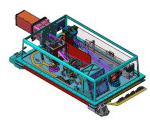Instrument Design
The SORCE SOLSTICE design [McClintock et al, 2000] has direct heritage to similar instruments onboard the UARS satellite. This image shows a representation of the implementation of each of the two identical spectrometers for SORCE.
Light enters the spectrometer through an entrance aperture, which is selected for either solar observations (a 0.1 mm square) or for stellar observations (a 16 mm diameter circular hole) using a bi-stable two-position rotation mechanism. A plane mirror, located 475 mm beyond the solar entrance aperture, reflects the beam onto a diffraction grating mounted in a precision single-axis gimbal. Rotating the gimbal to a specified angle causes the grating to diffract a small wavelength band of the original beam toward a second plane mirror. This mirror folds the beam and reflects it toward an off-axis ellipsoidal camera mirror. The camera mirror can be rotated into one of two positions, thereby directing the final beam path toward one of two detector assemblies. When the solar entrance aperture is in place, the camera mirror produces a demagnified image of it in the solar focal plane. Light from that image then passes through a 0.0375 mm wide × 4 mm tall exit slit located in the focal plane and impinges upon the input window of the selected photomultiplier detector. For stellar observations, the light is collimated when it reaches the instruments 16.0 mm diameter entrance aperture; and the camera mirror forms the stellar image at the stellar focal plane, slightly before the solar-mode focal plane. The larger stellar image size and different focal plane location are accommodated by using a two-position mechanism to rotate either a 0.75 mm × 4 mm (115 – 180 nm) or a 1.5 mm × 4 mm (170 – 320 nm) stellar exit slit into the stellar focal plane, replacing the solar exit slit.




